Related Research Articles

Vsevolod I Yaroslavich, ruled as Grand Prince of Kiev from 1078 until his death.

Iziaslav Yaroslavich was a Kniaz' (Prince) of Turov and Grand Prince of Kiev from 1054.
Sviatoslav II Iaroslavich or Sviatoslav II Yaroslavich was Grand Prince of Kiev between 1073 and 1076. He was born as a younger son of Grand Prince Yaroslav the Wise. His baptismal name was Nicholas.
Sviatopolk II Iziaslavich was supreme ruler of the Kievan Rus for 20 years, from 1093 to 1113. He was not a popular prince, and his reign was marked by incessant rivalry with his cousin Vladimir Monomakh.
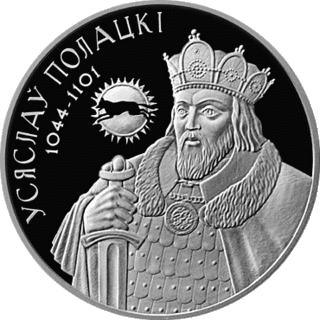
Vseslav of Polotsk or Vseslav Bryachislavich, also known as Vseslav the Sorcerer or Vseslav the Seer, was the most famous ruler of Polotsk and was briefly Grand Prince of Kiev in 1068–1069. Together with Rostislav Vladimirovich and voivode Vyshata, they created a coalition against the Yaroslaviches' triumvirate. Polotsk's Cathedral of Holy Wisdom is one of the most enduring monuments on the lands of modern Belarus and dates to his 57-year reign.
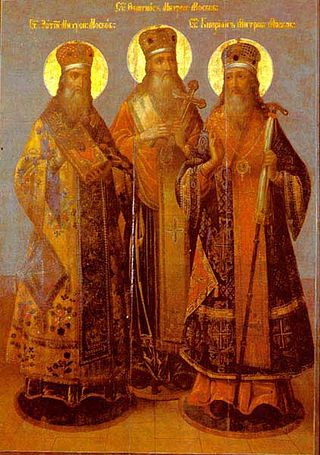
Cyprian was the Metropolitan of Kiev, Russia and Lithuania and the Metropolitan of Kyiv and All Rus' in the Ecumenical Patriarchate of Constantinople. During both periods, he was opposed by rival hierarchs and by the Grand Prince of Moscow. He was known as a bright opinion writer, editor, translator, and book copyist. He is commemorated by the Russian Orthodox Church on May 27 and September 16.
Oleg Svyatoslavich was a Rurikid prince whose equivocal adventures ignited political unrest in Kievan Rus' at the turn of the 11th and 12th centuries.

Anthony of Kiev also called Anthony of the Caves was a monk and the founder of the monastic tradition in Kievan Rus'. Together with Theodosius of Kiev, he co-founded the Kiev Pechersk Lavra.
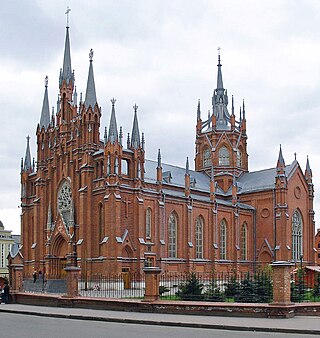
The Catholic Church in Russia is part of the worldwide Catholic Church, under the spiritual leadership of the Pope in Rome.
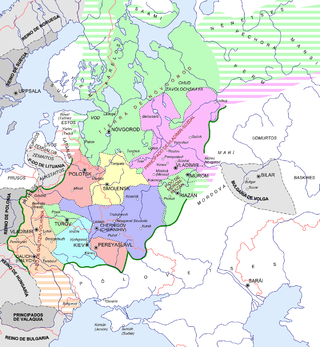
The inner Principality of Kiev was a medieval East Slavic state, situated in central regions of modern Ukraine around the city of Kiev (Kyiv).

Saint Ephraim II of Pereyaslav, also Saint Ephraim of the Caves or Saint Ephraim, Bishop of Pereslav - Eastern Orthodox saint, bishop of Pereiaslav, Ukraine).
The Battle of Alta River was a 1068 clash on the Alta River between Cuman army on the one hand and Kievan Rus' forces of Grand Prince Iziaslav I of Kiev, Prince Sviatoslav of Chernigov, and Prince Vsevolod of Periaslavl on the other in which the Rus' forces were routed and fled back to Kiev and Chernigov in some disarray. The battle led to an uprising in Kiev that briefly deposed Grand Prince Iziaslav. That incident supposedly shows the power of the Kiev veche and how common people gathering influenced princely politics in Kievan Rus'.
The Kiev uprising of 1068 was a revolt against Grand Prince Iziaslav Yaroslavich of Kiev in the aftermath of a Kievan Rus’ defeat at the hands of the Cumans at Battle of the Alta River near the city of Pereiaslavl, southeast of Kiev.
The Princes of Polotsk ruled the Principality of Polotsk within the realm of Kievan Rus or within the Grand Duchy of Lithuania from the mid ninth century to 1307.
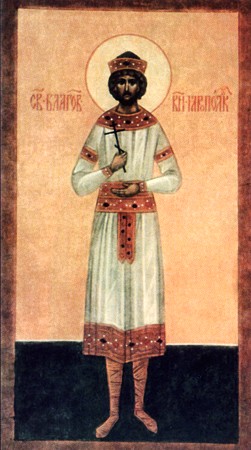
Yaropolk Iziaslavich or Yaropolk Iziaslavych was a Kniaz (prince) during the eleventh-century in the Kievan Rus' kingdom and was the King of Rus (1076–1087). The son of Grand Prince Iziaslav I of Kiev (Kyiv) by a Polish princess named Gertruda, he is visible in papal sources by the early 1070s but largely absent in contemporary Rus sources until his father's death in 1078. During his father's exile in the 1070s, Yaropolk can be found acting on his father's behalf in an attempt to gain the favor of the German emperors and the papal court of Pope Gregory VII. His father returned to Kiev in 1077 and Yaropolk followed.
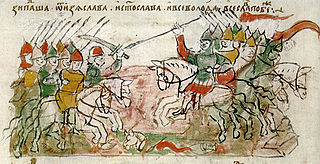
The Battle on the Nemiga River was a battle of the Kievan Rus' feudal period that occurred on March 3, 1067 on the Niamiha River. The description of the battle is the first reference to Minsk in the chronicles of Belarusian history.
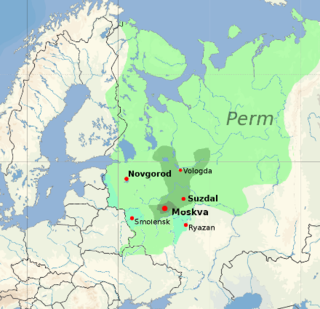
The Grand Duchy of Moscow, or simply Muscovy was a Rus' principality of the Late Middle Ages centered on Moscow, and the predecessor state of the Tsardom of Russia in the early modern period. It was ruled by a branch of the Rurik dynasty, which had reigned in Kievan Rus' since its foundation.

Kievan Rus', also known as Kyivan Rus', was a state and later an amalgam of principalities in Eastern and Northern Europe from the late 9th to the mid-13th century. Encompassing a variety of polities and peoples, including East Slavic, Norse, and Finnic, it was ruled by the Rurik dynasty, founded by the Varangian prince Rurik. The modern nations of Belarus, Russia, and Ukraine all claim Kievan Rus' as their cultural ancestor, with Belarus and Russia deriving their names from it. At its greatest extent in the mid-11th century, Kievan Rus' stretched from the White Sea in the north to the Black Sea in the south and from the headwaters of the Vistula in the west to the Taman Peninsula in the east, uniting the East Slavic tribes.
The Metropolis of Kiev and all Rus' was a metropolis of the Eastern Orthodox Church that was erected on the territory of Kievan Rus'. It existed between 988 AD and 1596 AD and later between 1620 AD and 1686 AD. Canonically, it was under the jurisdiction of the Ecumenical Patriarchate of Constantinople. The episcopal seat (cathedra) was located in the city of Kiev.
A schism between the Ecumenical Patriarchate and part ofitsMetropolis of Kiev and all Rus' occurred between approximately 1467 and 1560. This schism de facto ended supposedly around 1560.